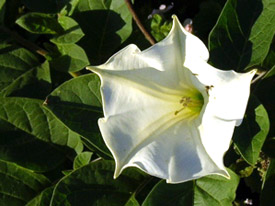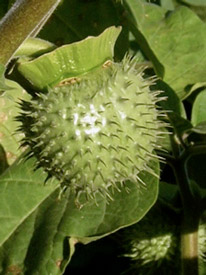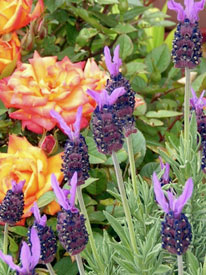
Datura flowers are beautiful and fragrant but beware: they are also toxic.
Question: We have a postage stamp yard in front of our patio home in North Myrtle Beach, South Carolina. I bought a plant in June that was described as a moon flower. I checked the Internet and found a moon flower that was a vine. Mine is now about 5 feet across and about 3-1/2 feet high — definitely not a vine. The flowers are white with a wonderful smell, and they open at night and last until midmorning the next day. I have had as many as 28 blooms in one night. There are spiny seedpods. How do I make sure I get the same plant next spring/summer?
Answer: If the flowers are like large, milky, white funnels, your plant is probably jimson weed (Datura stramonium), also called thorn apple, angel's trumpet, jimsonjade devil's weed, loco weed, and moonflower (because it often opens flowers throughout the night). This Nightshade family plant (related to tomatoes, potatoes, and peppers) is tough as nails and often grows into a lush specimen with dark stems, velvety leaves, and exquisite flowers. On the down side, jimson weed can become extremely weedy, plus all parts of it contain powerful alkaloids.

Remove datura seedpods if you don't want them to self-sow everywhere.
The name jimson weed is corrupted from Jamestown weed. Apparently, in 1676 some British soldiers in Jamestown, Virginia, mistakenly ate some Datura stramonium. They began to hallucinate, contort, and convulse. Their bizarre behavior lasted for days, and when they recovered, the soldiers had no memory of the incident. They were lucky. People have died from ingesting jimson weed. The simple lesson is: Don't it eat.
As for having the same plant next year, don't worry. The plant itself is only hardy to USDA zone 9, but it's a prolific seeder in nearly all zones. It typically volunteers freely throughout the garden. If you leave the plant to fully ripen the seedpods, you can let nature take its course and see where they pop up next year, or sow seeds yourself in preferred locations. If you want to collect seeds to sow next spring, snip off dried pods and store them in a cool, dark, dry area. Good luck and don't let this seductive beauty get out of hand.
Question: What is the best way to harvest seeds from peppers? I have never started seeds, I live in the city, and all my gardening is in pots. I have some seeds from a pepper that you cannot find in California and would like to be able to grow the plant.
Answer: Peppers are easy. For chile peppers, simply let the whole fruit dry, crush it, and remove seeds. Be careful when handling chile pepper seeds. They are covered in capsaicin, the chemical that brings the heat to hot peppers. Touching your nose or eyes after handling capsaicin can be disastrous. Some are so hot they will even make your fingers tingle! For bell peppers, cut off the tops of ripe fruit and dump out the seeds. Allow them to dry thoroughly for about two weeks.
Store all pepper seeds in sealed bags or jars in a cool, dry, dark location.
Question: Is there is a good time to prune a Japanese maple? I live in southern California and the winds are kicking up again. I protect my trees during cold spells or roll them into our enclosed patio, but I don't know how or when to prune.
Answer: Many garden experts would say, "Never!" Japanese maples can sulk after pruning. But if you have to shape one, then prune (don't shear) in spring. I often use pruned branches as filler in spring flower arrangements featuring alliums, Spanish bluebells, and iris.
Question: I grew herbs in pots this summer, and they did very well. A few are perennials (sage and rosemary). Should I plant them in the ground or will they survive in the pots?
Answer: Sage and rosemary will both survive in pots if you live in zone 7 or warmer. In zone 6, plant the rosemary in the ground. In zone 5, the rosemary probably won't survive outside in a pot or in the ground, but you could bring the plant inside for the winter.
Sage is quite hardy up to zone 5. I grow both of these plants in containers on my rooftop garden in Chicago (zone 5). The sage does just fine through the winter in a container. The rosemary is replaced annually. If you are concerned about them dying, be sure to harvest all the newer leaves (the fresh, green, tender ones near the end of the stems) for cooking.
Question: Should I bring in my lavender plant that's in a pot on my deck for the winter? I am not sure if it will survive a winter in a pot on the deck.
Answer: Lavender, like rosemary, is only reliably hardy to zone 7. If you live in zone 5 or colder, you can bring the pot indoors. However, keeping a lavender plant happy indoors in winter can be tough. They want cool temperatures and bright sunlight. Keep it away from radiators and heat vents.

Lavender and roses are one of my favorite rooftop container combos.
After killing one inside a few years ago, I now overwinter my lavenders in an unheated stairwell where the temperature remains just above 0 degrees F. Lavender does not want to be warm in winter. It is always worth trying to overwinter lavender. Even in the worst-case scenario, you gain experience and potpourri.
Question: I live in western North Carolina, and this year I had several dahlias that grew into huge plants. They have been planted two seasons and are well established. I don't dig and dry the tubers, I mulch them under several inches of cypress mulch. But I'd like to propagate my favorites without disturbing the existing plants. Can I collect the seeds and grow new plants from them?
Answer: You can sow the seeds but the offspring may not look exactly like the parent plant. They might exhibit other traits that are more or less favorable. Sow seeds outdoors in spring in a planting bed. After germination, thin the weakest seedlings. Some plants may flower the first year. In the spring of 2010, plant seedlings into the garden.
As for your established dahlias, you can dig them up and divide them. This method of asexual propagation is the only way to insure that you get the same plant next year. Plus, the tuberous roots seem to appreciate division and transplanting every year or so. You can leave them in the ground until after the last frost in spring. Then gently lift the clump with a garden fork and divide the tuberous roots so that each clump has a portion of stem with at least one bud. Replant throughout the garden.